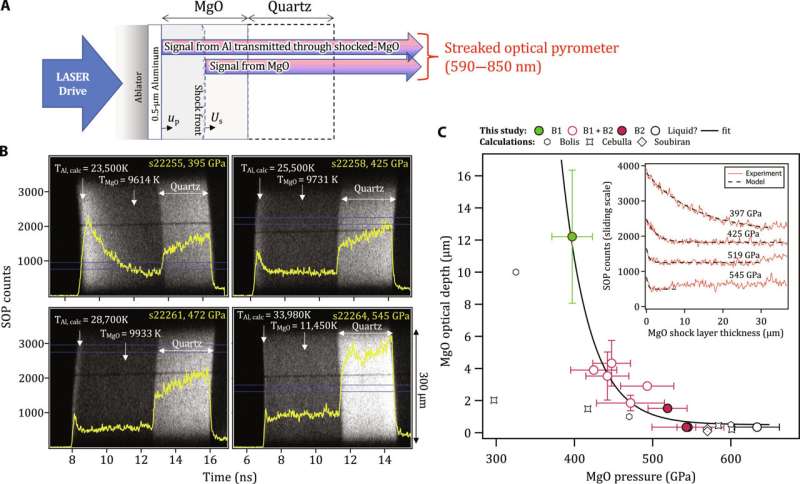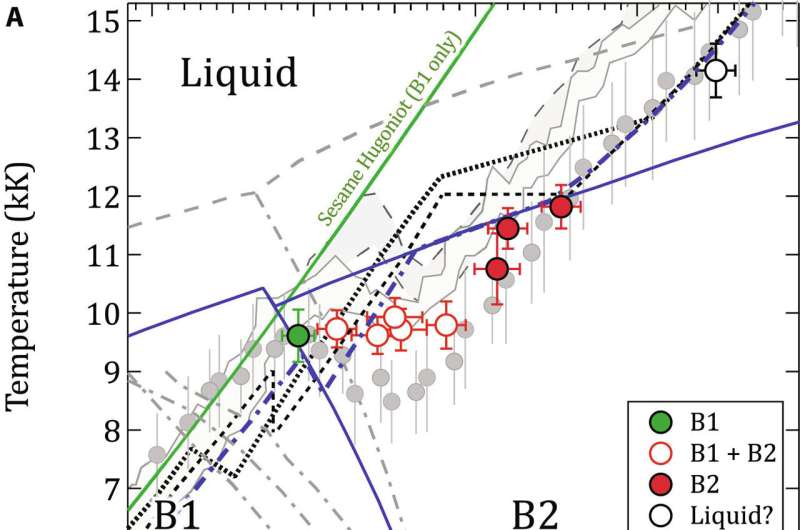This article has been reviewed according to Science X's editorial process and policies. Editors have highlighted the following attributes while ensuring the content's credibility:
fact-checked
peer-reviewed publication
trusted source
proofread
Study shows magnesium oxide undergoes dynamic transition when it comes to super-Earth exoplanets

Researchers from Lawrence Livermore National Laboratory (LLNL) and Johns Hopkins University have unlocked new secrets about the interiors of super-Earth exoplanets, potentially revolutionizing our understanding of these distant worlds.
The focus of this work, magnesium oxide (MgO), a crucial component of Earth's lower mantle, is believed to play a similar role in the mantles of massive rocky exoplanets. Known for its simple rock salt (B1) crystal structure and geophysical significance, MgO's behavior under extreme conditions has long intrigued scientists.
Super-Earths, planets with masses and radii larger than Earth but smaller than ice giants like Neptune, are often inferred to have compositions similar to terrestrial planets in our solar system. Given the extreme pressures and temperatures within their mantles, MgO is expected to transform from its B1 structure to a cesium chloride (B2) structure. This transformation significantly alters MgO's properties, including a dramatic decrease in viscosity, which can drastically affect the planet's internal dynamics.
To pinpoint the pressure at which this transition occurs, the LLNL team and collaborators devised a novel experimental platform. This platform combines laser-shock compression with simultaneous measurements of pressure, crystal structure, temperature, microstructural texture and density—an unprecedented approach.
Conducting 12 experiments at the Omega-EP laser facility at the University of Rochester's Laboratory for Laser Energetics, the scientists compressed MgO to ultra-high pressures of up to 634 GPa (6.34 million atmospheres) for several nanoseconds. Using a nanosecond X-ray source, they probed the atomic structure of MgO under these conditions.

The results were striking: the B1 to B2 phase transition in MgO occurred within the 400–430 GPa pressure range at a scorching temperature of around 9,700 K. Beyond 470 GPa, B2-liquid coexistence was observed, with complete melting at 634 GPa.
"This study provides the first direct atomic-level and thermodynamic constraints of the pressure-temperature onset of the B1 to B2 phase transformation and represents the highest-temperature X-ray diffraction data ever recorded," said LLNL scientist Ray Smith, author of a paper published in Science Advances. "These data are an essential for developing accurate models of super-Earth interior processes."
The B1–B2 transition is a model for other structural phase transformations, attracting decades of theoretical research focused on the atomic pathways facilitating this change. Using a forward model to simulate X-ray diffraction conditions, the research team was able to clarify the mechanism of the B1–B2 transition in MgO.
"Our X-ray diffraction data provides direct measurements of atomic-level changes in MgO under shock compression and the first determination of a phase transition mechanism at deep mantle pressures of super-Earth exoplanets," said LLNL scientist Saransh Soderlind.
Other study contributors include LLNL scientists Marius Millot, Dayne Fratanduono, Federica Coppari, Martin Gorman and Jon Eggert and collaborators from Johns Hopkins University, University of Rochester, Princeton University and SLAC National Accelerator Laboratory.
More information: June K. Wicks et al, B1-B2 transition in shock-compressed MgO, Science Advances (2024). DOI: 10.1126/sciadv.adk0306
Journal information: Science Advances
Provided by Lawrence Livermore National Laboratory





















